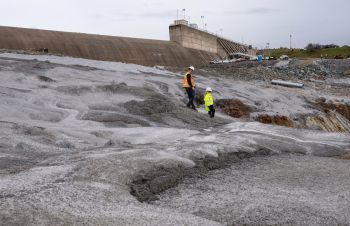Inspections

|
| Inspection of Oroville Dam's spillway.
(Image Source: Wikimedia) |
“Inspections of dams are necessary to ensure that they are functioning properly and safely. Inspections shall accomplish the following:[1]
- "Assess performance of the dam;
- "Determine compliance with the O&M Plan;
- "Assess the adequacy of previous O&M activities;
- "Identify O&M needs;
- "Identify conditions that may threaten life and property;
- "Identify any changed conditions that may affect the hazard classification; and
- "Develop a schedule to address O&M needs”.[1]
“Dams are built on the ground of materials extracted, in one form or another, from the ground; nature does not create a perfect dam site; there are always imperfections or areas of potential trouble. Identifying every such imperfection is not always possible no matter how extensive and thorough an investigation is made. However, limiting the potential for dam failures is possible: in design … in construction … and, perhaps most important of all, during operation, by inspections assessing both how actual performance compares with the designer’s prediction of performance and whether there are any trends indicating that adverse changes are occurring with time." [2]
“As the term ‘periodic inspection’ implies, evaluation of the safety of a dam and its appurtenant works is a never-ending process. While detailed onetime investigations that involve drilling, testing, and analysis are important and can provide much information that is necessary to help assess dam adequacy, they cannot be wholly conclusive by themselves, nor are the conclusions drawn necessarily valid for all time. As noted above, ensuring that one knows everything about an existing structure and its foundation is never possible; therefore, observation and evaluation of continuing performance are essential to help close the gaps in this knowledge”.[2]
“Furthermore, the condition of a dam or its foundation can change with time, due either to a natural ‘aging’ process or to the effects of such outside influences as earthquakes, long-term impoundment, or extreme weather variations. Again, observation and evaluation of continuing performance can provide the clues that something is taking place that requires further investigation and may require correction. Thus, field examinations, record reviews, the provision of additional data when required, and periodic reevaluation assume a paramount role in maintaining dam safety”.[2]
Types of Inspection
There are many different types of dam inspections including:
- Technical Inspection
- Emergency Inspection
- Owner Inspection
- Comprehensive Evaluation
- Conduit Inspection
- Confined Space Entry
- Remotely Operated Vehicle Inspection
The specific requirements associated with each of these types of inspections may differ based upon regulatory jurisdiction of the dam.
Best Practices Resources
![]() Pocket Safety Guide for Dams and Impoundments, FEMA
Pocket Safety Guide for Dams and Impoundments, FEMA
![]() Technical Manual: Conduits through Embankment Dams, FEMA
Technical Manual: Conduits through Embankment Dams, FEMA
Trainings
![]() Dam Owner Academy: Dam Inspections
Dam Owner Academy: Dam Inspections
![]() YouTube: Introduction to Inspecting Dams for Owners and Operators
YouTube: Introduction to Inspecting Dams for Owners and Operators
![]() On-Demand Webinar: Low-Level Conduits – What Can Go Wrong, How to Inspect, How to Repair?
On-Demand Webinar: Low-Level Conduits – What Can Go Wrong, How to Inspect, How to Repair?
![]() Technical Seminar: Inspection and Assessment of Dams
Technical Seminar: Inspection and Assessment of Dams
Citations:
Revision ID: 7326
Revision Date: 07/19/2023
